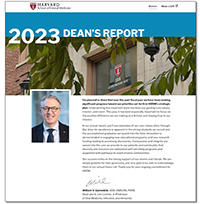
Dr. Yingzi Yang, professor of developmental biology at HSDM, leads a laboratory of seven postdoctoral researchers and three visiting scholars researching skeletal development—particularly how the skeletal system forms and how skeletal diseases arise.
“We have a long-standing interest in skeletal development, although most of the time we are investigating how the skeletal system forms, our ultimate goal is to understand the cellular and molecular mechanisms underpinning skeletal diseases,” Yang said.
Prior to joining HSDM in 2014, Yang was a senior investigator and head of the Developmental Genetics Section in the Genetic Disease Research Branch of the National Human Genome Research Institute (NHGRI). Her work is widely recognized for bridging discoveries of fundamental mechanisms with characterization of skeletal diseases including severe skeletal birth defects, osteoporosis, osteoarthritis and heterotopic bone formation.
“There are many skeletal diseases out there that we still don’t have a cure for, so those are major medical challenges. For example, osteoporosis is a severe problem in older populations. Our previous research on Wnt and Hedgehog signaling provided some insights there,” Yang said.
“More recently, we are getting into genetic diseases of the skeletal system,” she said. By studying rare genetic bone diseases, she hopes to uncover mechanisms that can be applied to more common diseases as well.
The wide range of funded skeletal research projects in the Yang Lab look at conditions such as Heterotopic ossification (HO), a condition that can occurs with injury or trauma, where bone forms in soft tissue; another project looks at fibrosis in the bone marrow; and yet another examines cartilage morphogenesis in long bones.
“By looking at cartilage morphogenesis in long bones, and why they elongate in certain direction, this has tremendous implications in diseases such as dwarfism, cleft palate, and even spina bifida—a condition with an open neural tube,” Yang said.
Yang’s research has significant implications in dental craniofacial research and well beyond.
“As a researcher in medicine, our goal is to also provide a very fundamental understanding of many more physiological or pathophysiological processes. Basic research and medical research are two faces of the same coin.”
“When you’re trying to address a problem in craniofacial development, often what you find can be applied to other places. It’s not limited to only dental implications,” she said.
Yang recently became director of the PhD in Biological Sciences in Dental Medicine program at HSDM. The program, offered to students accepted into the DMD program at HSDM, provides the opportunity to for students to earn a PhD while earning a DMD degree. It offers advanced study in the molecular, supramolecular, cellular, and supracellular processes that provide the intellectual basis for dental medicine. Research can be conducted at any Harvard-affliated institutions, as well as Massachusetts Institute of Technology.
“One of the missions of the dental school is to provide a nurturing environment to train the next generation of leaders in dental practice and research. We should encourage our students to become leaders in academia as well. We need to train them how to do research—the best research,” Yang said.


